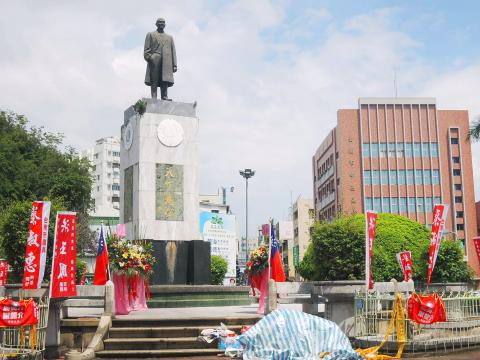Following a standoff between supporters and protesters at the Tang Te-chang Park in Greater Tainan yesterday, the Greater Tainan Government announced that it would delay a plan to relocate a statue of Republic of China founding father Sun Yat-sen (孫逸仙).
The controversy over the statue started in early February, when Northern Taiwan Society executive head Sherry Huang (黃淑純) complained that there was only a half-lifesize statue of 228 Incident hero Tang Te-chang (湯德章) on the periphery of the park, while a full-size bronze statue of Sun was prominently placed in the center.
Tang was a lawyer in Tainan during the 228 Incident and was burning a list of names of people who participated in the activities of the local Settlement Committee when Nationalist soldiers showed up to arrest him.

Photo: Hung Jui-chin, Taipei Times
He was severely beaten while he put up a fierce resistance in a bid to allow the list to be burned completely. He was executed the following day.
His actions saved the lives of a number of leading Tainan residents and students whose names were on the list.
The 228 Incident refers to an uprising in 1947 against the then-Chinese Nationalist Party (KMT) regime and the resulting brutal crackdown that left tens of thousands dead, and led to nearly four decades of martial law.
The city government had originally planned to relocate Sun’s statue to the Ka Ba Sua Elementary School’s Shueiyun campus in Dongshan District (東山) on Friday.
The KMT caucus in the city council, as well as the Greater Tainan KMT headquarters branch, strongly condemned the move and also criticized Greater Tainan Mayor William Lai’s (賴清德) actions.
The KTM city councilors took turns standing beside Sun’s statue to guard against it being removed and their resolve was bolstered by visits from others who protested against the decision to remove the statue.
There was even a flower basket allegedly sent by Sun’s granddaughter, Lily Sui-fong Sun (孫穗芳), reading: “Many thanks to the people of Tainan who stood guard for my family.”
City government supporters waved banners in front of the National Museum of Taiwanese Literature, which is near the park, and said that the city government was right in giving Tang justice because he was a victim of the 228 Incident.
Seeing the banners, protesters made a banner of their own, reading: “The founding father also wants his living rights.”
Meanwhile, the city government took down the scaffolding that had been erected around the statue and announced a delay in the relocation, but said that the relocation was inevitable.
The relocation is to safeguard the rights of residents and to protect a historical relic, the city government said, adding that other counties and cities had done the same thing.
The relocation of statues to be collectively stored in one location is very common, the city government said, adding that the relocation of the statue had nothing to do with politics.
The decision was completely legal and we would like to ask for the support of residents, the city government said.

Trips for more than 100,000 international and domestic air travelers could be disrupted as China launches a military exercise around Taiwan today, Taiwan’s Civil Aviation Administration (CAA) said yesterday. The exercise could affect nearly 900 flights scheduled to enter the Taipei Flight Information Region (FIR) during the exercise window, it added. A notice issued by the Chinese Civil Aviation Administration showed there would be seven temporary zones around the Taiwan Strait which would be used for live-fire exercises, lasting from 8am to 6pm today. All aircraft are prohibited from entering during exercise, it says. Taipei FIR has 14 international air routes and

The Ministry of National Defense (MND) today released images of the military tracking China’s People's Liberation Army (PLA) movements during the latest round of Chinese drills around Taiwan. The PLA began "Justice Mission 2025" drills today, carrying out live-fire drills, simulated strikes on land and maritime targets, and exercises to blockade the nation's main ports. The exercises are to continue tomorrow, with the PLA announcing sea and air space restrictions for five zones around Taiwan for 10 hours starting from 8:30am. The ministry today released images showing a Chinese J-16 fighter jet tracked by a F-16V Block 20 jet and the

Snow fell on Yushan (Jade Mountain, 玉山) yesterday morning as a continental cold air mass sent temperatures below freezing on Taiwan’s tallest peak, the Central Weather Administration (CWA) said. Snowflakes were seen on Yushan’s north peak from 6:28am to 6:38am, but they did not fully cover the ground and no accumulation was recorded, the CWA said. As of 7:42am, the lowest temperature recorded across Taiwan was minus-5.5°C at Yushan’s Fengkou observatory and minus-4.7°C at the Yushan observatory, CWA data showed. On Hehuanshan (合歡山) in Nantou County, a low of 1.3°C was recorded at 6:39pm, when ice pellets fell at Songsyue Lodge (松雪樓), a

City buses in Taipei and New Taipei City, as well as the Taipei MRT, would on Saturday begin accepting QR code payments from five electronic payment providers, the Taipei Department of Transportation said yesterday. The new option would allow passengers to use the “transportation QR code” feature from EasyWallet, iPass Money, iCash Pay, Jkopay or PXPay Plus. Passengers should open their preferred electronic payment app, select the “transportation code” — not the regular payment code — unlock it, and scan the code at ticket readers or gates, General Planning Division Director-General Liu Kuo-chu (劉國著) said. People should move through the